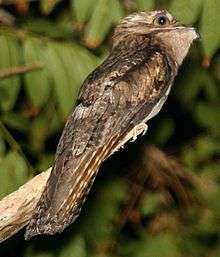Northern potoo
| Northern potoo | |
|---|---|
 | |
| Scientific classification | |
| Kingdom: | Animalia |
| Phylum: | Chordata |
| Class: | Aves |
| Order: | Caprimulgiformes |
| Family: | Nyctibiidae |
| Genus: | Nyctibius |
| Species: | N. jamaicensis |
| Binomial name | |
| Nyctibius jamaicensis (Gmelin, 1789) | |
The northern potoo (Nyctibius jamaicensis) is a nocturnal bird belonging to the potoo family, Nyctibiidae. It is found from Mexico south to Costa Rica and on the islands of Jamaica and Hispaniola. It was formerly classified as a subspecies of the common potoo (Nyctibius griseus) but is now usually treated as a separate species based on differences in vocalizations.
Description
It is a fairly large bird with a length of 38-46 centimetres. It has a long tail, long pointed wings, large head, very short legs and a small bill with a large gape. It is most commonly seen perched motionless in an upright position on branches or posts. The plumage is grey-brown with an intricate pattern of black, grey and cream markings. The cheeks are pale with a dark malar stripe below them. The large eye has a yellow iris which can shine red in light at night. The bird's calls are hoarse and guttural.
The common potoo is virtually identical in appearance but has a very different voice consisting of a series of mournful, wailing whistles. The great potoo is larger and paler with no dark malar stripe.
Distribution and subspecies
It has five subspecies distributed across Middle America and the West Indies. N. j. jamaicensis is restricted to Jamaica while N. j. abbotti is found on Hispaniola with a single report from Mona Island in Puerto Rico. N. j. lambi is found in western Mexico extending north as far as southern Sinaloa. N. j. mexicanus occurs in southern and eastern Mexico north to southern parts of San Luis Potosí and Tamaulipas as well as in Guatemala, Belize, El Salvador and Honduras. N. j. costaricensis is the most southerly form, occurring in western Nicaragua and north-west Costa Rica.
Ecology
It mainly occurs in lowland areas where it inhabits woodland and scrubland with clearings and farmland with scattered trees. It is sometimes seen around golf courses and urban areas. It feeds on large insects such as moths or beetles. It hunts from a perch, sitting and waiting for prey then sallying out to catch it in flight.
A single egg is laid on a broken branch with no nest material used. Both parents are involved in incubating the egg and feeding the young bird.
References
- ↑ BirdLife International (2012). "Nyctibius jamaicensis". IUCN Red List of Threatened Species. Version 2013.2. International Union for Conservation of Nature. Retrieved 26 November 2013.
- American Ornithologists Union (1995) Fortieth supplement to the American Ornithologists' Union Check-list of North American Birds. Auk 112:819-830.
- Clements, James F. (2007) The Clements Checklist of Birds of the World, 6th ed., Cornell University Press, Ithaca, New York.
- Downer, Audrey & Sutton, Robert (1990) Birds of Jamaica: A Photographic Field Guide, Cambridge University Press, Cambridge.
- Garrigues, Richard & Dean, Robert (2007) Birds of Costa Rica, Christopher Helm, London.
- Raffaele, Herbert; Wiley, James; Garrido, Orlando; Keith, Allan & Raffaele, Janis (2003) Birds of the West Indies, Christopher Helm, London.
External links
- Northern potoo videos on the Internet Bird Collection
| Wikispecies has information related to: Nyctibius jamaicensis |
- InfoNatura: Nyctibius jamaicensis - Northern potoo.
- Mangoverde World Bird Guide: Northern Potoo Nyctibius jamaicensis.
- Northern potoo photo gallery VIREO Photo-High Res
- Photo-High Res; Article sos-wildlifejamaica
- Photo-Medium Res; Article tropicalbirding
